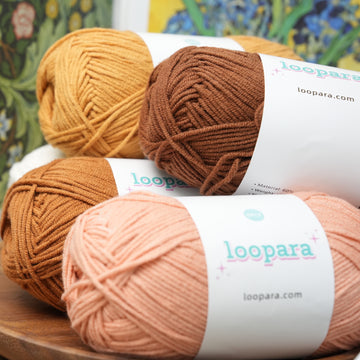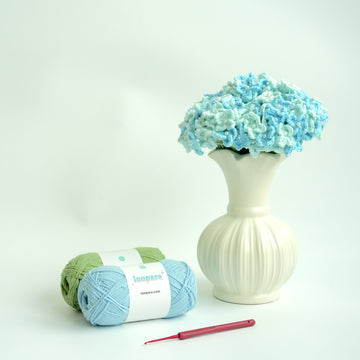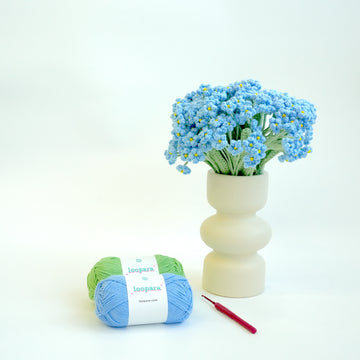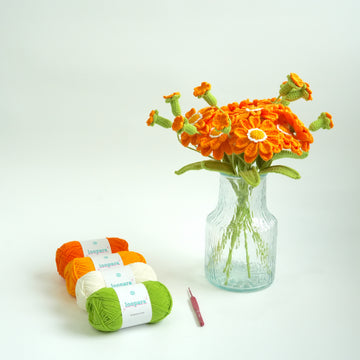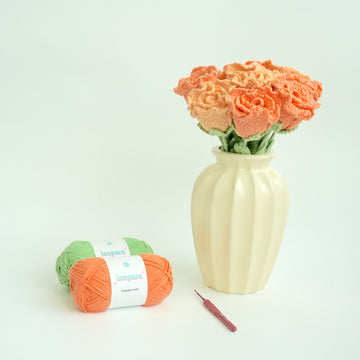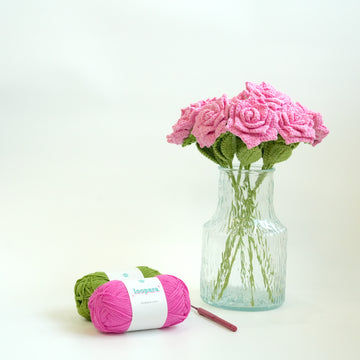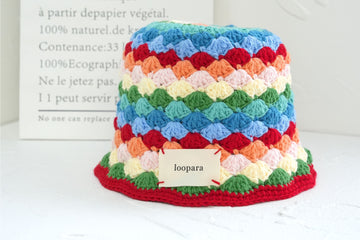Acrylic yarn is one of the most popular choices for crochet and knitting. It’s widely available, inexpensive, and comes in a wide range of weights and colors. But does acrylic shrink?
Spoiler alert: the answer is no! But if you’re thinking about what happens when you put acrylic in the washing machine, that isn’t all you need to know.
To get the complete picture, we’ll explore how acrylic yarn is made, and what that means for its properties. We’ll look at its pros and cons. And we’ll see how it measures up against some alternatives.
Does acrylic shrink like wool does?
Acrylic yarn was developed as an alternative to wool.
Wool is a great option for crocheting and knitting because it’s light yet warm, looks good, and is available in lots of colors.
But it can be expensive. And it has one major drawback: if you launder wool at too high a temperature, it will shrink.
We’ve probably all had that sinking feeling. You open the washing machine, pull out your favorite jumper, and discover it’s now only big enough for a teddy bear.
What’s happened is that the wool has felted - the fibers have contracted and matted together. That’s happened because of the combination of heat and movement.
It’s actually possible to wash wool at a high temperature without it shrinking – but only if it stays completely still. So if you want to put it in the washing machine, it needs to go on a wool or delicates cycle, at a lower temperature.
Acrylic doesn’t have this problem. Put an acrylic jumper in a 40-degree wash, and it will emerge the same size as it went in. That’s because the fibers that make up acrylic are very smooth, so they won’t felt.
What happens when acrylic yarn is washed?

So far, this is good news for acrylic. But that’s not the end of the story.
If you search online, you’ll find the general consensus is that acrylic is very robust. It’s true that it’s resistant to mildew and sunlight. And it won’t shrink in temperatures below 120 degrees, so won’t be affected by even the hottest cycle in your washing machine.
But it is affected by washing. And to understand how, we need to understand what it’s made from.
Acrylic yarn is made from fossil fuels – mainly from a substance called polyacrylonitrile. It’s essentially a form of spun plastic. That’s why it has those smooth fibers that don’t get matted on a hot wash.
What does happen, though, is that washing causes tiny particles of plastic, known as microplastics, to be released from the yarn. A study by the University of Plymouth showed that a single load of acrylic items in a washing machine released an astonishing 730,000 microplastic particles into the water system.
These find their way into the sea, where they do immense damage to marine life. They also find their way into the human body, where they’ve been connected to chronic disease.
In contrast, natural fibers, like wool and cotton, don’t produce microplastics at all. And acrylic is a bigger culprit than other synthetic fibers too. In the Plymouth study, acrylic yarns released 1.5 times as many microplastics as polyester when washed.
Your acrylic garment might not show signs of wear and tear from washing. But it is being affected at a structural level. And human beings, and the rest of the planet, are feeling the effects.
The problem of stretching
When clothes are put into a washing machine, they encounter water, detergent, and heat. But that’s not all. They’re also agitated by the movement of the drum.
That movement is designed to help release stains and get the clothes thoroughly clean. But it can also have some less desirable effects.
Depending on how tightly stitched the acrylic is, the washing machine action can loosen threads and stretch the item. That’s particularly likely to be a problem with crocheted items, because of the holes between stitches.
And if you hang the garment up to dry, the weight of the water can drag on the stitches too. That could leave you with misshapen clothing.
Drying and ironing acrylic
Acrylic yarn melts at temperatures above 120 degrees Celsius. That might be hotter than the hottest wash in your washing machine. But it’s a temperature that can easily be reached by the steam in an iron.
If you’re using a very hot iron, you might find your acrylic jumper sticks to the plate, damaging both iron and garment. But it’s more likely that the melting fibers will simply go floppy and shiny.
If you’ve ever noticed unattractive shiny patches on your ironed acrylic clothing, that’s probably why.
And it takes slightly less heat – above 110 degrees Celsius – to cause acrylic to shrink. So while your jumper will stay the same size in the washing machine, the tumble dryer is a different story. Modern dryers typically reach temperatures of around 150 degrees Celsius.
So to avoid shrinkage, leave acrylic items to air dry.
Other pros and cons of acrylic
As we’ve seen, acrylic yarn can be damaged by washing, drying and ironing. But how it will be laundered is only one of many considerations when choosing a yarn. Let’s take a look at the other pros and cons of acrylic in more detail.
Other pros of acrylic
- Acrylic yarn is affordable. If you’re making a crochet project on a budget, acrylic yarn makes good financial sense. And if you’re crocheting a large item, like a blanket, the difference in cost between acrylic and wool will be significant.
- Acrylic is widely available. Wherever you’re located, it’s likely that your nearest yarn store will have a good selection of acrylic yarns. They’ll be available in a wide range of weights and colors too.
- Acrylic resists mildew. The smooth fibers of acrylic yarn make it an inhospitable environment for mildew.
- Some acrylic yarns are hypoallergenic. Look for yarns with the OEKO-TEX Standard 100 certification on the label. That guarantees that the yarn has passed tests for the presence of over 1,000 toxic substances.
Other cons of acrylic
- Acrylic isn’t as warm as wool. Acrylic might look like wool, but it doesn’t have the same insulating properties. Acrylic-wool blends are warmer, while pure wool is warmer still.
- Acrylic isn’t breathable. Acrylic doesn’t allow air to travel through it. That means you may sweat more if you’re wearing acrylic than a natural fiber like wool or cotton.
- Acrylic isn’t suitable for home-dyeing. That’s because it isn’t easy for the dye particles to cling to the smooth plastic fibers. There are specialist dyes out there specifically for use with acrylics, but even they will tend to give you dull colors. If you want to dye your own yarn, wool or cotton will give you much better results.
Alternatives to acrylic yarn
If you’re looking for an alternative to acrylic, natural fibers could be a good option. Here we look at the pros and cons of wool and cotton, and see how they measure up against acrylic.
1. Wool
Pros:
- Wool is warmer than acrylic, so it’s a good choice for cold weather garments.
- Wool is machine washable, as long as you use a wool or delicates cycle and suitable detergent.
- Wool is breathable, so you’ll sweat less in a wool sweater than an acrylic one.
- Like acrylic, wool is available in a range of colors and weights.
- Superfine and ultrafine merino wool can help manage eczema.
Cons:
- Wool is more expensive than acrylic. And some types of wool are more expensive than others. Lambswool is more expensive than sheep’s wool, and merino is more expensive again.
- If you pick the wrong washing machine cycle, wool will felt – and there’s very little you can do to undo the damage.
- Around 1 in 50 people are allergic to lanolin, the oil in wool.
2. Cotton

Pros:
- Cotton is widely available in a choice of colors and weights.
- Cotton is breathable and wicks away moisture. That makes it a good choice for summer clothing.
- Cotton is washable and doesn’t pill (i.e. form bobbles on the surface).
- Cotton, and especially mercerized cotton, is good at absorbing dyes.
Cons:
- Though less expensive than wool, cotton is still generally pricier than acrylic.
- It’s not as warm as acrylic.
- The fibers are harder, so can be more difficult to work with.
- Cotton requires large quantities of water to be grown, and is typically exported over long distances. And unless it’s organic, it will have been produced using large quantities of pesticides and fertilisers.
Does acrylic shrink: the key facts
Acrylic garments won’t shrink in the wash. But contrary to popular belief, they do need special care. They will shrink if they’re put into the tumbler dryer. And a hot iron can cause the fabric to get shiny and floppy.
There are other side effects from washing acrylic to consider too. Washing it in the machine releases large quantities of microplastics into the water system. Those are harmful to both humans and the planet.
Like acrylic, wool shouldn’t go into the tumble dryer. But it can be machine-washed as long as you use the right cycle and detergent. And it won’t release toxins into your home and the environment.


